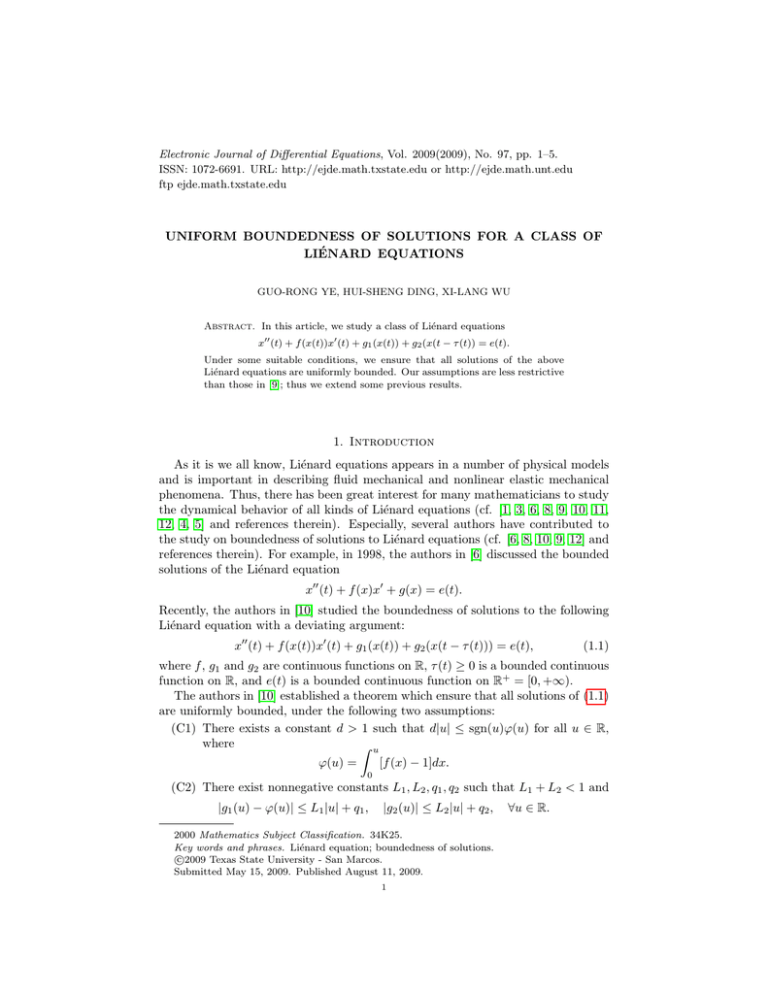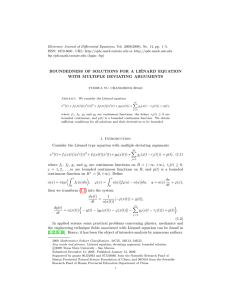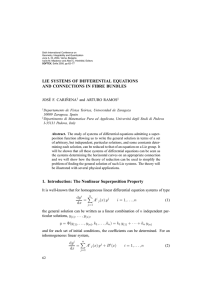Electronic Journal of Differential Equations, Vol. 2009(2009), No. 97, pp.... ISSN: 1072-6691. URL: or
advertisement

Electronic Journal of Differential Equations, Vol. 2009(2009), No. 97, pp. 1–5.
ISSN: 1072-6691. URL: http://ejde.math.txstate.edu or http://ejde.math.unt.edu
ftp ejde.math.txstate.edu
UNIFORM BOUNDEDNESS OF SOLUTIONS FOR A CLASS OF
LIÉNARD EQUATIONS
GUO-RONG YE, HUI-SHENG DING, XI-LANG WU
Abstract. In this article, we study a class of Liénard equations
x00 (t) + f (x(t))x0 (t) + g1 (x(t)) + g2 (x(t − τ (t)) = e(t).
Under some suitable conditions, we ensure that all solutions of the above
Liénard equations are uniformly bounded. Our assumptions are less restrictive
than those in [9]; thus we extend some previous results.
1. Introduction
As it is we all know, Liénard equations appears in a number of physical models
and is important in describing fluid mechanical and nonlinear elastic mechanical
phenomena. Thus, there has been great interest for many mathematicians to study
the dynamical behavior of all kinds of Liénard equations (cf. [1, 3, 6, 8, 9, 10, 11,
12, 4, 5] and references therein). Especially, several authors have contributed to
the study on boundedness of solutions to Liénard equations (cf. [6, 8, 10, 9, 12] and
references therein). For example, in 1998, the authors in [6] discussed the bounded
solutions of the Liénard equation
x00 (t) + f (x)x0 + g(x) = e(t).
Recently, the authors in [10] studied the boundedness of solutions to the following
Liénard equation with a deviating argument:
x00 (t) + f (x(t))x0 (t) + g1 (x(t)) + g2 (x(t − τ (t))) = e(t),
(1.1)
where f , g1 and g2 are continuous functions on R, τ (t) ≥ 0 is a bounded continuous
function on R, and e(t) is a bounded continuous function on R+ = [0, +∞).
The authors in [10] established a theorem which ensure that all solutions of (1.1)
are uniformly bounded, under the following two assumptions:
(C1) There exists a constant d > 1 such that d|u| ≤ sgn(u)ϕ(u) for all u ∈ R,
where
Z u
ϕ(u) =
[f (x) − 1]dx.
0
(C2) There exist nonnegative constants L1 , L2 , q1 , q2 such that L1 + L2 < 1 and
|g1 (u) − ϕ(u)| ≤ L1 |u| + q1 ,
|g2 (u)| ≤ L2 |u| + q2 ,
2000 Mathematics Subject Classification. 34K25.
Key words and phrases. Liénard equation; boundedness of solutions.
c
2009
Texas State University - San Marcos.
Submitted May 15, 2009. Published August 11, 2009.
1
∀u ∈ R.
2
G.-R. YE, H.-S. DING, X.-L. WU
EJDE-2009/97
In this article, we will make further study on this problem. As one will see,
under weaker assumptions than (C1) and (C2), we also get the same conclusion to
[10]. Next, let us recall some notations and basic results.
Throughout this paper, we denote
Z x
dx
ϕ(x) =
[f (u) − 1]du, y =
+ ϕ(x).
dt
0
Then (1.1) is transformed into the system
dx(t)
= −ϕ(x(t)) + y(t),
dt
(1.2)
dy(t)
= −y(t) − [g1 (x(t)) − ϕ(x(t))] − g2 (x(t − τ (t)) + e(t).
dt
Let h = supt∈R τ (t) ≥ 0. C([−h, 0], R) denotes the space of continuous functions
φ : [−h, 0] → R with the supremum norm k · k. It is well known (cf. [2, 7]) that
for any given continuous initial function φ ∈ C([−h, 0], R) and a number y0 , there
exists a solution of (1.2) on an interval [0, T ) satisfying the initial conditions and
(1.2) on [0, T ). If the solution remains bounded, then T = +∞. We denote such a
solution by x(t) = x(t, φ, y0 ), y(t) = y(t, φ, y0 ).
Definition 1.1 ([10]). Solutions of (1.2) are called uniformly bounded if for each
B1 > 0 there is a B2 > 0 such that (φ, y0 ) ∈ C([−h, 0], R) × R and kφk + |y0 | ≤ B1
implies that |x(t, φ, y0 )| + |y(t, φ, y0 )| ≤ B2 for all t ∈ R+ .
2. Main results
For our convenience, we list the following assumptions:
(A1) |u| < sgn(u)ϕ(u) for all u ∈ R.
(A2) There exist two nondecreasing functions G, Φ defined on R+ such that
|g1 (u) − ϕ(u)| ≤ Φ(|u|),
|g2 (u)| ≤ G(|u|),
lim sup[Φ(x) + G(x) − x + e] < 0,
∀u ∈ R,
e = sup |e(t)|.
x→+∞
t∈R+
Theorem 2.1. Suppose that (A1), (A2) hold. Then solutions of (1.2) are uniformly
bounded.
Proof. Let x(t) = x(t, φ, y0 ), y(t) = y(t, φ, y0 ) be a solution of (1.2). Calculating
the upper right derivatives of |x(s)| and |y(s)|, in view of (A1) and (A2), we have
D+ (|x(s)|)|s=t = sgn(x(t)){−ϕ(x(t)) + y(t)}
< −|x(t)| + |y(t)|,
+
D (|y(s)|)|s=t = sgn(y(t)){−y(t) − [g1 (x(t)) − ϕ(x(t))] − g2 (x(t − τ (t)) + e(t)}
≤ −|y(t)| + Φ(|x(t)|) + G(|x(t − τ (t))|) + e.
Let
M (t) = max {max{|x(s)|, |y(s)|}},
−h≤s≤t
t ≥ 0.
By (A2), there is a constant M > 0 such that
Φ(x) + G(x) − x + e < 0,
For any given t0 ≥ 0, we consider five cases.
x ≥ M.
(2.1)
EJDE-2009/97
UNIFORM BOUNDEDNESS OF SOLUTIONS
3
Case (i): M (t0 ) > max{|x(t0 )|, |y(t0 )|}. It follows from the continuity of x(t)
and y(t) that there exists δ1 > 0 such that
max{|x(t)|, |y(t)|} < M (t0 ),
∀t ∈ (t0 , t0 + δ1 ).
Thus, one can conclude M (t) = M (t0 ), for all t ∈ (t0 , t0 + δ1 ).
Case (ii): M (t0 ) = max{|x(t0 )|, |y(t0 )|} < M . Also, by the continuity of x(t)
and y(t), there exists δ2 > 0 such that
max{|x(t)|, |y(t)|} < M,
∀t ∈ (t0 , t0 + δ2 ).
Therefore, M (t) < M , for all t ∈ (t0 , t0 + δ2 ).
Case (iii): M (t0 ) = max{|x(t0 )|, |y(t0 )|} = |x(t0 )| ≥ M , and |x(t0 )| > |y(t0 )|.
Since
D+ (|x(s)|)|s=t0 < −|x(t0 )| + |y(t0 )| < 0,
there exists δ3 > 0 such that
|x(t)| < |x(t0 )| = M (t0 ) ∀t ∈ (t0 , t0 + δ3 ).
On the other hand, by the continuity of y(t), without loss, one can assume that
|y(t)| < |x(t0 )| = M (t0 ),
∀t ∈ (t0 , t0 + δ3 ).
So
max{|x(t)|, |y(t)|} < M (t0 ),
∀t ∈ (t0 , t0 + δ3 ),
which implies M (t) = M (t0 ), for all t ∈ (t0 , t0 + δ3 ).
Case (iv): M (t0 ) = max{|x(t0 )|, |y(t0 )|} = |y(t0 )| ≥ M , and |x(t0 )| < |y(t0 )|.
By (2.1), we have
D+ (|y(s)|)|s=t0 ≤ −|y(t0 )| + Φ(|x(t0 )|) + G(|x(t0 − τ (t0 ))|) + e
≤ −M (t0 ) + Φ(M (t0 )) + G(M (t0 )) + e < 0,
which yields that there exists δ4 > 0 such that
|y(t)| < |y(t0 )| = M (t0 ),
∀t ∈ (t0 , t0 + δ4 ).
On the other hand, without loss of generality, one can assume that
|x(t)| < |y(t0 )| = M (t0 ),
∀t ∈ (t0 , t0 + δ4 ).
So one can conclude
max{|x(t)|, |y(t)|} < M (t0 ),
∀t ∈ (t0 , t0 + δ4 ).
Thus M (t) = M (t0 ) for all t ∈ (t0 , t0 + δ4 ).
Case (v): M (t0 ) = max{|x(t0 )|, |y(t0 )|} = |x(t0 )| = |y(t0 )| ≥ M . We have
D+ (|x(s)|)|s=t0 < −|x(t0 )| + |y(t0 )| = 0.
Also, similar to the proof of Case (iv), one can show that
D+ (|y(s)|)|s=t0 < 0.
Thus, there exists δ5 > 0 such that
|x(t)| < |x(t0 )| = M (t0 ),
|y(t)| < |y(t0 )| = M (t0 ) ∀t ∈ (t0 , t0 + δ5 ).
Therefore, M (t) = M (t0 ) for all t ∈ (t0 , t0 + δ5 ). In summary, for each t0 ≥ 0, there
exists δ > 0 such that
M (t) ≤ max{M (t0 ), M },
∀t ∈ (t0 , t0 + δ).
4
G.-R. YE, H.-S. DING, X.-L. WU
EJDE-2009/97
Let
inf{t ≥ 0 : M (t) > max{M (0), M }}
if {t ≥ 0 : M (t) > max{M (0), M }} =
6 ∅,
α=
+∞
if {t ≥ 0 : M (t) > max{M (0), M }} = ∅.
We claim that α = +∞. If α < +∞, then
M (t) ≤ max{M (0), M },
∀t ∈ [0, α].
(2.2)
It follows from the above proof that there is a constant δ 0 > 0 such that
∀t ∈ (α, α + δ 0 ).
M (t) ≤ max{M (α), M },
(2.3)
Combing (2.2) and (2.3), we have
∀t ∈ [0, α + δ 0 ),
M (t) ≤ max{M (0), M },
which yields α ≥ α + δ 0 . This is a contradiction. Thus, α = +∞, which implies
M (t) ≤ max{M (0), M },
∀t ≥ 0.
Then, we have
|x(t)| ≤ max{M (0), M },
|y(t)| ≤ max{M (0), M },
∀t ≥ 0.
Therefore, solutions of (1.2) are uniformly bounded.
Remark 2.2. One can easily conclude (A1) and (A2) from the assumptions (C1)
and (C2). So Theorem 2.1 is a generalization of [10, Theorem 3.1]. In addition, our
assumptions are weaker than (C1) and (C2) in essence (see Remark 2.4).
Next, we give an example to illustrate our results.
Example 2.3. Consider the following Liénard equation:
x00 (t) + f (x(t))x0 (t) + g1 (x(t)) + g2 (x(t − τ (t)) = e(t),
where
e−x − xe−x
xe−x + 3x + x1/3
+ 2, g1 (x) =
,
2
2
g2 (x) = x1/3 , τ (t) = cos2 t, e(t) = sin t.
f (x) =
Then
Z
x
[f (u) − 1]du =
ϕ(x) =
0
1 −x
xe + x,
2
and
sgn(x)ϕ(x) =
1 −x
e + 1 |x| > |x|,
2
∀x ∈ R.
So (A1) holds. In addition, let
Φ(x) =
x + x1/3
,
2
G(x) = x1/3 .
Then
u + u1/3 ≤ Φ(|u|),
|g1 (u) − ϕ(u)| = 2
|g2 (u)| = G(|u|),
∀u ∈ R,
(2.4)
EJDE-2009/97
UNIFORM BOUNDEDNESS OF SOLUTIONS
5
and
x + x1/3
+ x1/3 − x + 1 < 0,
2
x→+∞
e = sup |e(t)| = 1.
lim sup[Φ(x) + G(x) − x + e] = lim sup
x→+∞
t∈R+
So (A2) holds. Then Theorem 2.1 shows that solutions of (2.4) are uniformly
bounded.
Remark 2.4. In the above example, there is no a constant d > 1 such that
sgn(x)ϕ(x) ≥ d|x|,
∀x ∈ R.
So (C1) does not hold. Thus, [10, Theorem 3.1] can not be applied.
Acknowledgments. Hui-Sheng Ding acknowledges support from the NSF of China
(10826066), the NSF of Jiangxi Province of China (2008GQS0057), the Youth Foundation of Jiangxi Provincial Education Department (GJJ09456), and the Youth
Foundation of Jiangxi Normal University. Guo-Rong Ye and Xi-Lang Wu acknowledge support from the Graduate Innovation Foundation of Jiangxi Normal University (JXSD-Y-09045).
References
[1] C. Bereanu; Multiple periodic solutions of some Liénard equations with p-Laplacian, Bull.
Belg. Math. Soc. Simon Stevin 15 (2008), 277–285.
[2] T. A. Burton; Stability and Periodic Solutions of Ordinary and Functional Differential Equations, Academic Press, Orland, FL, 1985.
[3] N. P. Các; Periodic solutions of a Liénard equation with forcing term, Nonlinear Anal. 43
(2001), 403–415.
[4] P. Cieutat; On the structure of the set of bounded solutions on an almost periodic Liénard
equation, Nonlinear Anal. 58 (2004), 885–898.
[5] P. Cieutat; Almost periodic solutions of forced vectorial Liénard equations, J. Differential
Equations 209 (2005), 302–328.
[6] A. Fonda, F. Zanolin; Bounded solutions of nonlinear second order ordinary differential equations, Discrete and Continuous Dynamical Systems, 4 (1998), 91–98.
[7] J. K. Hale; Theory of Functional Differential Equations, Springer-Verlag, New York, 1977.
[8] L. Huang, Y. Cheng, J. Wu; Boundedness of solutions for a class of nonlinear planar systems,
Tohoku Math. J. 54 (2002), 393–419.
[9] B. Liu, L. Huang; Boundedness for a class of retarded Liénard equation, J. Math. Anal. Appl.
286 (2003), 422–434.
[10] B. Liu, L. Huang; Boundedness of solutions for a class of Liénard equations with a deviating
argument, Appl. Math. Lett. 21 (2008), 109–112.
[11] B. Toni; Almost and pseudo-almost limit cycles for some forced Liénard systems, Nonlinear
Anal., in press.
[12] G. Villari; On the qualitative behavior of solutions of the Liénard equation, J. Differential
Equations 67 (1987) 267–277.
College of Mathematics and Information Science, Jiangxi Normal University, Nanchang, Jiangxi 330022, China
E-mail address, G.-R. Ye: yeguorong2006@sina.com
E-mail address, H.-S. Ding: dinghs@mail.ustc.edu.cn
E-mail address, X.-L. Wu: wuxilang99@sina.com

![MA3422 (Functional Analysis 2) Tutorial sheet 7 [March 13, 2015] Name: Solutions](http://s2.studylib.net/store/data/010731576_1-7cab095e21e09d2afe2aa723de414bb1-300x300.png)
